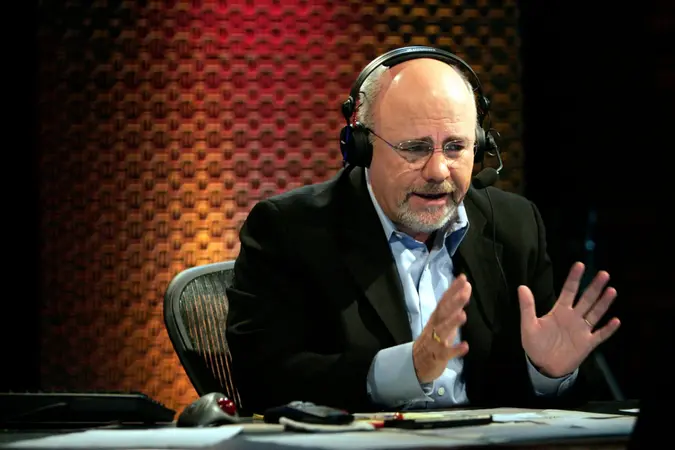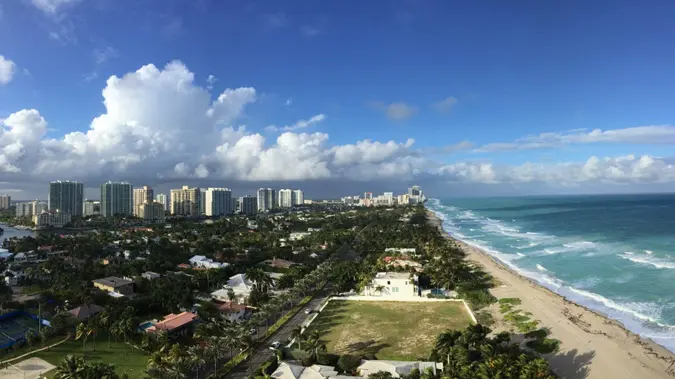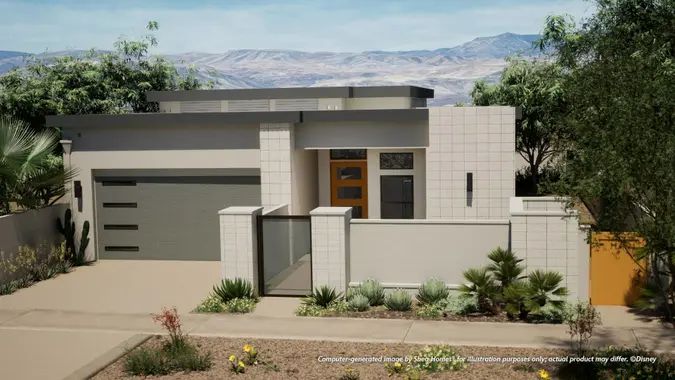How To Save for a House in 2025: Simple Ways to Start Saving Today
Commitment to Our Readers
GOBankingRates' editorial team is committed to bringing you unbiased reviews and information. We use data-driven methodologies to evaluate financial products and services - our reviews and ratings are not influenced by advertisers. You can read more about our editorial guidelines and our products and services review methodology.

20 Years
Helping You Live Richer

Reviewed
by Experts

Trusted by
Millions of Readers
There are two reasons why saving for a house as early as possible has never been more important than today. First, home prices have exploded in value since the pandemic, in some cases more than doubling. Second, the Fed jacked up interest rates dramatically in 2022 and 2023 to combat the highest inflation rates in 40 years. Combined, these two factors have pushed homes to near-record levels of unaffordability.
But this doesn’t mean that you should give up on your dream of buying a house. It just means that you should start earlier than ever to save for a new home and do all you can to come up with a sizable down payment. A larger down payment will reduce your monthly mortgage costs, build immediate equity in your home and protect you from having to pay private mortgage insurance or PMI.
Here are some simple steps you can take to save even more money for your new home.
Setting a Savings Goal
It’s hard to reach a savings goal until you know what it is. To set your savings goal, you’ll need to know the approximate value of the home you want to buy. Then, you use online calculators to help you set your goal, using a variety of different down payments. The ideal down payment is at least 20%, because you’ll avoid PMI and you’ll have a sizable equity cushion in case the market goes down. But you may be able to put down as little as 3% through various programs offered by government agencies like Freddie Mac and Fannie Mae, according to The Mortgage Reports.
Understanding how a varying down payment affects your total mortgage cost is an important part of the process. Imagine, for example, that you plan to buy a $400,000 home and you can get a mortgage with a 6.5% interest rate. After a 20% down payment of $80,000 up front, your monthly mortgage payment would be $2,022.62. Over the course of your 30-year loan, you’d pay $408,142.36 in interest.
A 3% down payment, on the other hand, would only require a down payment of $12,000. However, your monthly mortgage payment would jump to $2,452.42. Over the course of your loan, your total interest paid would amount to $494,872.62, or more than $90,000 extra.
Creating a Budget for Saving
The whole idea of a budget is to track where your money goes every month. If you’re creating a new budget that includes saving for a down payment, you may have to trim your spending in other areas in order to reach your goals.
The first step in creating a budget is to identify your monthly income and expenses. Include a line item for every single inflow or outflow. If you’ve already got a substantial amount set aside every month for saving, that’s great! Simply reallocate some of your savings budget to your down payment savings. But if you’re living paycheck to paycheck and find it hard to make ends meet, you might have to make some tough decisions. For example, you might have to reduce your monthly subscription cost for things like streaming services, or you might have to trim your budget for eating out.
However, that’s exactly why budgeting is helpful. When you draft an accurate budget, you can see at a glance exactly where you may have to trim expenses to meet your savings goal.
Opening a Dedicated Savings Account
If you want to help save for a down payment, it’s best if you open a separate savings account for this single purpose. If you try to use a single savings account for all of your individual financial goals, it’s far too easy to dip into this “general” fund and divert money away from your housing account. Plus, it can make it difficult to know exactly how much you have saved for that specific goal.
If you’re trying to maximize your savings, look for accounts that pay the highest yields. As opposed to a traditional bank savings account, which will often pay a low yield, high-yield savings and money market accounts often pay top APY rates. Just be sure the bank you’re looking at is a legitimate bank with FDIC insurance and that its customer service reviews are positive.
Once you’ve established your dedicated savings account, automate your transfers so that you never fail to make a contribution. If you’re left to your own devices to “remember” to set aside money every month, it can become far too easy to “forget” a month here or there, or to find an excuse to use that money for something else.
Ways To Increase Your Savings
There are only two ways that you can increase your savings: boosting your income and/or reducing your expenses. Here are ways to do both:
- Cut back on non-essential spending: This is the time to make a clear delineation between “needs” and “wants.” While there’s only so far you can trim your food budget, for example, there’s no need to eat out five nights a week — or at all, if you’re serious about saving.
- Make more money: You may have to put in some legwork, but you might discover that making more money isn’t as hard as you think. In addition to asking your employer for a raise, you can also pick up a side gig or two, freelance or even ask for extra hours at work.
- Get out of debt — or at least stop digging: Debt is the albatross around the neck of every financial plan. Every dollar you pay in interest is one that doesn’t go to your savings. If you can’t pay off all your debt right away, make sure to allocate a portion of your budget to getting out of that hole as soon as possible. And by all means, do not ever take on additional debt while you are trying to save for a house.
Exploring Down Payment Assistance Programs
Various federal, state and local down payment assistance programs may be available to potential homebuyers. This is particularly true for first-time homebuyers with lower incomes.
According to The Mortgage Reports, there are four main types of down payment assistance programs:
- Grants, which never have to be repaid.
- Loans, which can be repaid at low or no interest.
- Forgivable loans, in which debt is forgiven after a number of years, typically 5 to 10
- Tax credits, which allow savings of up to $2,000 per year on federal taxes
Generally, you’ll need a credit score of at least 620 to qualify. You’ll also have to meet various income requirements.
The pros of down payment assistance programs are obvious — those who need help with making a down payment can receive grants, loans or other aid that can get a buyer into a home rapidly, at a potentially reduced expense.
However, there are some cons to be aware of also. Not all lenders accept these types of programs, and it can be hard to qualify for them. Receiving assistance may also inadvertently push you into buying more home than you can afford, since less money will be coming out of your pocket upfront.
Types of Mortgages and How They Affect Your Savings
Although most potential homeowners are familiar with conventional mortgages, there are a number of different types of mortgages that can affect how much you need to save for a down payment.
If you can qualify for a VA mortgage, for example, you can put as little as 0% down without having to pay private mortgage insurance. FHA-insured loans allow down payments as low as 3.5% for those with a credit score of at least 580, or 10% for those with scores between 500 and 579, according to Nolo.
Obviously, if you can qualify for a 0% VA mortgage, then you can move into a home as soon as you can afford the monthly payment. While this payment will be larger with 0% down, at least you won’t have to pay PMI, and you’ll also be able to own a home almost immediately. An FHA loan requires a minimal down payment, similarly allowing you to acquire a home faster than with a conventional mortgage.
Strategies to Speed Up Your Savings
In addition to earning more money and/or spending less, there are some “outside-the-box” methods to accelerate your savings. Here are a few ideas:
- Move to a more affordable area: If you can cut your cost of living by 10%, 20%, or even 50%, you’ll get to your savings goal much faster. Imagine, for example, that you live in Los Angeles and want to buy a home there. On a temporary basis, perhaps you could move to the Central Valley, or even another state, until you return and buy your dream home. While you might not quite have the life you want for a few years, you’ll be able to save much faster than if you simply stayed in high-cost Los Angeles — and this means you can also be back in the city in your new home much more quickly.
- Bank all windfall payments: Any time you get a bonus, a tax refund, or any other type of unexpected or “found” money, immediately transfer it to your savings account. The longer you hold onto it, the more likely you are to spend it on other items, some of which may be “wants” instead of “needs.” But if you bank all of your windfall payments, you’ll reach your savings goal much sooner.
- Reward yourself: Saving can’t be all about denying yourself pleasure in life. Set up milestones along the way to your ultimate goal and reward yourself with a little treat each time you reach the next set of goalposts.
FAQ
- How much should I save for a down payment?
- Generally, experts recommend a down payment of at least 20%. This allows you to avoid paying private mortgage insurance and gives you immediate equity in your home.
- How long will it take me to save for a house?
- A number of variables determine how long it will take to save for a house, from its price to mortgage rates to your income and ability to save. Generally speaking, however, it takes most Americans a number of years to save a down payment. A Zillow study cited by the New York Times suggests that a worker earning the median wage in America and saving 10% of their income would take about 12 years on average to save for a down payment.
- Can I use a gift from my family for my down payment?
- Yes, you can use gifted money from anyone to help with a down payment.
- Are there alternatives to saving for a down payment?
- In some cases, you may be able to qualify for a mortgage with a 10%, 3.5% or even 0% down payment, alleviating the need for a sizable down payment -- or even any down payment at all.
 Written by
Written by  Edited by
Edited by 

























